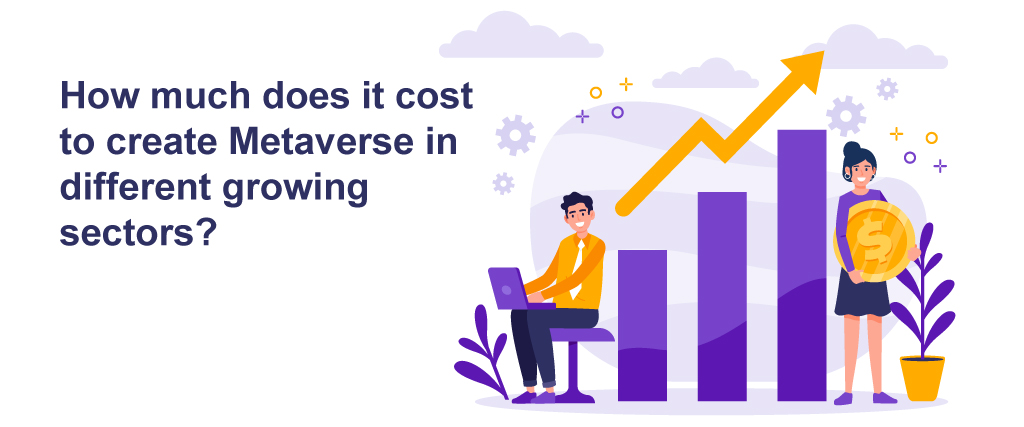In this article, people can get an idea about the Metaverse development cost.
The Metaverse is a virtual reality that combines elements of physical and virtual reality, including augmented reality and the internet, to create a shared space that can be accessed by multiple users.
It is thought to have the potential to significantly change the way society functions and operates.
It’s usually described as a virtual reality (VR) shared by millions of individuals, and it has the potential to transform the way we live and work.
One question that many people have about the Metaverse is: how much does it cost to develop?
In this blog post, we’ll explore the factors that go into the cost of developing the Metaverse, and provide some estimates for what it might cost to build your own Metaverse experience.
● What are the Factors affecting the Metaverse development cost?
There are several factors that can affect the cost of Metaverse development, including:
The complexity of the design:
The more complex the design of the Metaverse, the more expensive it will be to develop.
This includes things like the number of virtual environments or “worlds” that need to be created, as well as the level of detail and interactivity of those environments.
Size of the development team:
The larger the team of developers working on the project, the more it will cost.
Length of development:
The longer it takes to develop the Metaverse, the more it will cost.
This is because developers need to be paid for their time, and the longer the project takes, the more time they will need to spend on it.
Use of external resources:
If the development team needs to use external resources, such as specialized software or third-party contractors, this can add to the overall cost.
Ongoing maintenance and updates:
After the Metaverse is launched, there will likely be ongoing costs associated with maintaining and updating the platform.
This could include bug fixes, new feature development, and server costs.
● What are the key features of the metaverse?

There are many potential features that could be included in a Metaverse, depending on the specific goals and intended use of the platform.
Some potential features could include:
Virtual worlds or environments:
The Metaverse could include a variety of virtual worlds or environments, ranging from realistic recreations of real-world locations to completely fantastical settings.
Avatars:
Users could create and customize their own avatars to represent themselves in the Metaverse.
Social interactions:
The Metaverse could enable users to interact with each other in various ways, such as through voice and text chat, as well as more immersive social experiences like virtual parties or events.
Virtual commerce:
Users could buy and sell virtual goods and services within the Metaverse.
Virtual reality experiences:
The Metaverse could offer a wide range of virtual reality experiences, such as immersive games or educational simulations.
Augmented reality integration:
The Metaverse could incorporate elements of augmented reality, allowing users to see virtual objects and information overlaid in the real world.
Integration with real-world systems:
The Metaverse could be connected to various real-world systems, such as transportation networks or financial systems, enabling users to interact with these systems in new ways.
● What does the Metaverse tech stack include?
The tech stack for a Metaverse will depend on the specific goals and design of the platform, as well as the development team’s expertise and resources.
Some potential technologies that could be included in a Metaverse tech stack include:
Virtual reality engines and 3D modeling software
To create immersive virtual environments, the Metaverse may use virtual reality engines such as Unity or Unreal Engine.
To develop virtual objects and environments, the development team may use 3D modeling software such as Blender or Autodesk 3ds Max.
Networking technology & Cloud Infrastructure
To enable users to interact with each other in real-time within the Metaverse, the platform will need to use networking technology such as WebRTC or Photon.
To host and scale the Metaverse, the development team may use cloud infrastructures such as Amazon Web Services or Microsoft Azure.
Database systems and security technologies
To store user data and virtual objects within the Metaverse, the platform may use database systems such as MySQL or MongoDB.
To ensure the security and privacy of user data, the Metaverse will likely need to incorporate various security technologies such as encryption and authentication systems.
What is the Industry-wise Metaverse development cost?
Gaming
The gaming industry may be one of the most expensive industries in which to develop a Metaverse, as it will likely require highly detailed and immersive virtual environments, as well as advanced gaming mechanics and features.
On average, the development cost of the Metaverse game
can range from $30,000 to $300,000, based on the type of technology used to develop the game.
Education
A basic Metaverse for educational purposes may not require a lot of complexity or detail, but it will still need to be able to handle a large number of users and potentially incorporate features such as virtual classrooms and learning materials.
The cost of developing metaverse in this sector could range from tens of thousands to hundreds of thousands of dollars.
Social media
The development of social media platforms has been driven not only by competition, but also by the need to address issues such as data privacy, intrusive ads, and the need to stay ahead with new ideas.
The Metaverse, as an extension of social media, represents one such new concept.
The Metaverse allows for the integration of various aspects of social media, including live entertainment, collaboration, commerce, and immersive experiences, through the use of augmented and virtual reality.
However, the cost of developing a Metaverse social media platform can vary widely, ranging from $25,000 to $400,000, depending on the features and technologies included.
Conclusion
It’s important to note that these estimates are rough and could vary significantly depending on the specific goals and design of the Metaverse, as well as the expertise and resources of the development team.

Tech industry leaders anticipate that the Metaverse will continue to evolve and improve, enabling the creation of various practical applications that will improve its ability to replicate real-life functioning.
Yugasa Software Labs specializes in providing advanced Metaverse development services to accommodate the numerous potential use cases for the technology.
Get in touch with us to start planning and strategizing for your Metaverse vision.
Read More: MICROSOFT REVEALS PLANS FOR METAVERSE: A NEW VIRTUAL WORLD FOR THE ENTERPRISE
























